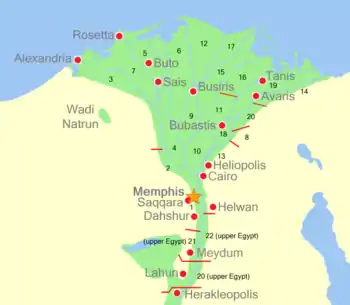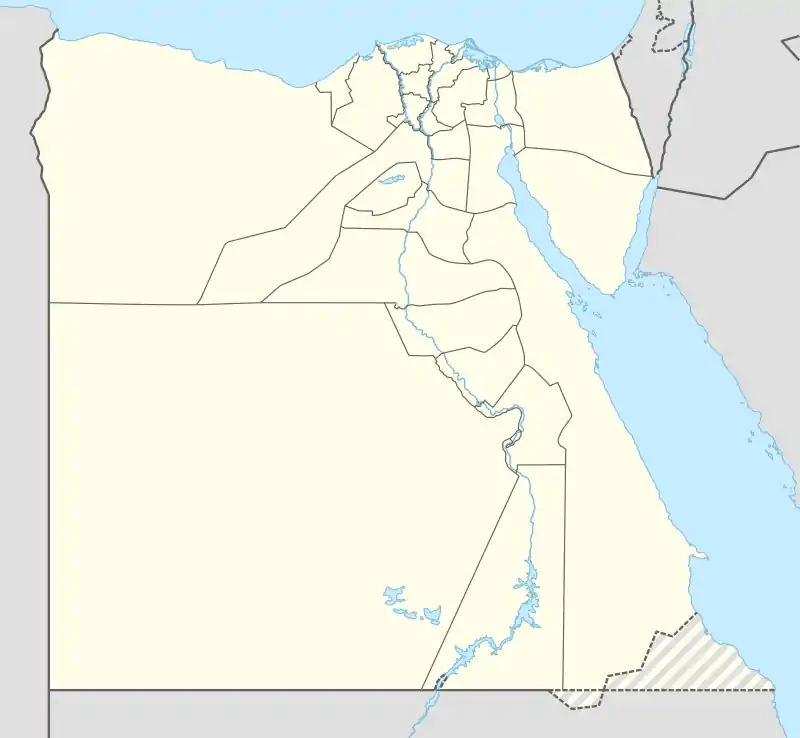Lower Egypt ⲧⲥⲁϧⲏⲧ, ⲡⲥⲁⲙⲉⲛϩⲓⲧ مصر السفلى | |||||||||
|---|---|---|---|---|---|---|---|---|---|
| c. 3500 BC–c. 3100 BC | |||||||||
| Capital | Memphis | ||||||||
| Common languages | Ancient Egyptian | ||||||||
| Religion | Ancient Egyptian religion | ||||||||
| Government | Monarchy | ||||||||
| King | |||||||||
• Unknown | Unknown (first) | ||||||||
• c. 3150 BC | Unknown (last) | ||||||||
| History | |||||||||
• Established | c. 3500 BC | ||||||||
• Disestablished | c. 3100 BC | ||||||||
| |||||||||
| Today part of | Egypt | ||||||||


Lower Egypt (Arabic: مصر السفلى Miṣr as-Suflā; Coptic: ⲧⲥⲁϧⲏⲧ, romanized: Tsakhet) is the northernmost region of Egypt, which consists of the fertile Nile Delta between Upper Egypt and the Mediterranean Sea, from El Aiyat, south of modern-day Cairo, and Dahshur. Historically, the Nile River split into seven branches of the delta in Lower Egypt.
Lower Egypt was divided into nomes and began to advance as a civilization after 3600 BC.[1] Today, it contains two major channels that flow through the delta of the Nile River – Mahmoudiyah Canal (ancient Agathos Daimon) and Muways Canal (Arabic: بحر موَيس, "waterway of Moses").
Name
In Ancient Egyptian, Lower Egypt was known as mḥw which means "north".[2] Later on, during Antiquity and the Middle Ages, Greeks and Romans called it Κάτω Αἴγυπτος or Aegyptus Inferior both meaning "Lower Egypt", but Copts carried on using the old name related to the north – Tsakhet (Coptic: ⲧⲥⲁϧⲏⲧ) or Psanemhit (Coptic: ⲡⲥⲁⲛⲉⲙϩⲓⲧ) meaning the "Northern part". It was further divided into a number of regions or nomes (Coptic: ⲡⲧⲟϣ, romanized: ptosh) – Niphaiat (Coptic: ⲛⲓⲫⲁⲓⲁⲧ, lit. 'Libyan (nome)', Ancient Greek: Μαρεωτης) in the west, Tiarabia (Coptic: ϯⲁⲣⲁⲃⲓⲁ, lit. 'Arabia') in the east, Nimeshshoti (Coptic: ⲛⲓⲙⲉϣϣⲟϯ, lit. 'fields') in the north-east and Bashmur (Bashmuric Coptic: ⲡⲥⲁⲙⲏⲣ, lit. 'sand shore') in the north. Champollion adds another region in the middle of the Delta which he calls Petmour (Coptic: ⲡⲉⲧⲙⲟⲩⲣ, lit. 'the one which bounds, girds')[3] based on Ancient Greek: Πτιμυρις mentioned by Stephanus of Byzantium, but it is unclear if this is a separate region or just a Greek rendering of the name Bashmur.[4]
After the Muslim conquest, the middle part of the Delta was called al-Rif (Arabic: الريف) which means "countryside, rural area" and which is derived from Ancient Egyptian
r-pr, "temple", because the rural areas were administered by them.[5] The eastern part roughly comprising the ancient Tiarabia was called al-Hawf (Arabic: الهوف) meaning "edge, fringe".[6]
Geography
Today, there are two principal channels that the Nile takes through the river delta: one in the west at Rashid and one in the east at Damietta.
The delta region is well watered, crisscrossed by channels and canals.
Owing primarily to its proximity to the Mediterranean Sea, the climate in Lower Egypt is milder than that of Upper Egypt, the southern portion of the country. Temperatures are less extreme and rainfall is more abundant in Lower Egypt.
History
It was divided into twenty districts called nomes, the first of which was at el-Lisht. Because Lower Egypt was mostly undeveloped scrubland, filled with all types of plant life such as grasses and herbs, the organization of the nomes underwent several changes.
The capital of Lower Egypt was Memphis. Its patron goddess was the goddess Wadjet, depicted as a cobra. Lower Egypt was represented by the Red Crown Deshret, and its symbols were the papyrus and the bee. After unification, the patron deities of both Lower Egypt and Upper Egypt were represented together as the Two Ladies, Wadjet and Nekhbet (depicted as a vulture), to protect all of the ancient Egyptians.
By approximately 3600 BC, Neolithic Egyptian societies along the Nile River had based their culture on the raising of crops and the domestication of animals.[7] Shortly after 3600 BC, Egyptian society began to grow and advance rapidly toward refined civilization.[1] A new and distinctive pottery, which was related to the pottery in the Southern Levant, appeared during this time. Extensive use of copper became common during this time.[1] The Mesopotamian process of sun-dried bricks, and architectural building principles—including the use of the arch and recessed walls for decorative effect—became popular during this time.[1]
Concurrent with these cultural advances, a process of unification of the societies and towns of the upper Nile River, or Upper Egypt, occurred. At the same time, the societies of the Nile Delta, or Lower Egypt also underwent a unification process.[1] Warfare between Upper Egypt and Lower Egypt occurred often.[1] During his reign in Upper Egypt, King Narmer defeated his enemies in the Delta and merged the kingdoms of Upper Egypt and Lower Egypt under his single rule.[8]
List of kings of the Predynastic Period of Lower Egypt
| Periods and dynasties of ancient Egypt |
|---|
|
All years are BC |
|
See also: List of pharaohs by period and dynasty Periodization of ancient Egypt |
The Palermo stone, a royal annal written in the mid Fifth Dynasty (c. 2490 BC – c. 2350 BC) records a number of kings reigning over Lower Egypt before Narmer. These are completely unattested outside these inscriptions:
| Name |
|---|
| Hsekiu[9] |
| Khayu[9] |
| Tiu[9] |
| Thesh[9] |
| Neheb[9] |
| Wazner[9] |
| Mekh[9] |
| (destroyed)[9] |
In contrast, the following kings are attested through archeological finds from Sinai and Lower Egypt: Double Falcon, Crocodile.
List of nomes
| History of Egypt |
|---|
 |
|
|
| Number | Egyptian Name | Capital | Modern name of capital site | English Translation | God |
|---|---|---|---|---|---|
| 1 | Inebu-hedj | Ineb Hedj / Men-nefer / Menfe (Memphis) | Mit Rahina | White Walls | Ptah |
| 2 | Khensu | Khem (Letopolis) | Ausim | Cow's thigh | Horus |
| 3 | Imnt | Imu (Apis) | Kom el-Hisn | West | Hathor |
| 4 | Zapi-Res | Ptkheka | Tanta | Southern shield | Sobek, Isis, Amun |
| 5 | Zapi-Meh | Zau (Sais) | Sa el-Hagar | Northern shield | Neith |
| 6 | Khaset | Khasu (Xois) | Sakha | Mountain bull | Amun-Ra |
| 7 | A-ment | (Hermopolis Parva, Metelis) | Damanhur | West harpoon | Hu |
| 8 | A-bt | Tjeku / Per-Atum (Heroonpolis, Pithom) | Tell el-Maskhuta | East harpoon | Atum |
| 9 | Ati | Djed (Busiris) | Abu Sir Bara | Andjeti | Osiris |
| 10 | Ka-khem | Hut-hery-ib (Athribis) | Banha (Tell Atrib) | Black bull | Horus |
| 11 | Ka-heseb | Taremu (Leontopolis) | Tell el-Urydam | Heseb bull | Isis |
| 12 | Theb-ka | Tjebnutjer (Sebennytos) | Samanud | Calf and Cow | Onuris |
| 13 | Heq-At | Iunu (Heliopolis) | Materiya (suburb of Cairo) | Prospering Sceptre | Ra |
| 14 | Khent-abt | Tjaru (Sile, Tanis) | Tell Abu Sefa | Eastmost | Horus |
| 15 | Tehut | Ba'h / Weprehwy (Hermopolis Parva) | Baqliya | Ibis | Thoth |
| 16 | Kha | Djedet (Mendes) | Tell el-Rubˁ | Fish | Banebdjedet, or Hatmehyt |
| 17 | Semabehdet | Semabehdet (Diospolis Inferior) | Tell el-Balamun | The throne | Amun-Ra |
| 18 | Am-Khent | Per-Bastet (Bubastis) | Tell Bastah (near Zagazig) | Prince of the South | Bastet |
| 19 | Am-Pehu | Dja'net (Leontopolis Tanis) | Tell Nebesha or San el-Hagar | Prince of the North | Uatchet |
| 20 | Sopdu | Per-Sopdu | Saft el-Hinna | Plumed Falcon | Sopdet |
See also
References
- 1 2 3 4 5 6 Carl Roebuck, The World of Ancient Times (Charles Scribner's Sons: New York, 1966) p. 52-53.
- ↑ "TM Places". www.trismegistos.org. Retrieved 2019-11-16.
- ↑ Champollion, Jean-François (1814). L'Égypte sous les pharaons, ou recherches sur la géographie, la religion, la langue, les écritures et l'histoire de l'Égypte avant l'invasion de Cambyse. Paris: Bure. p. 5.
- ↑ "Schwartze, Moritz Gotthilf: Das alte Aegypten oder Sprache, Geschichte, Religion und Verfassung des alten Aegyptens: nach den altägyptischen Original-Schriften und den Mittheilungen der nichtägyptischen alten Schriftsteller (Band 2) (Leipzig, 1843)". digi.ub.uni-heidelberg.de. Retrieved 2022-11-29.
- ↑ "ريف - Wiktionary". en.wiktionary.org. Retrieved 2021-05-28.
- ↑ Adel, Arsanious (23 December 2019). "Administrative Organization Of Egypt - Coptic Wiki". Retrieved 2021-05-28.
- ↑ Carl Roebuck, The World of Ancient Times (Charles Scribner's Sons Publishing: New York, 1966) p. 51.
- ↑ Carl Roebuck, The World of Ancient Times (Charles Scribner's Sons Publishers: New York, 1966), p. 53.
- 1 2 3 4 5 6 7 8 Breasted (1909) p.36
